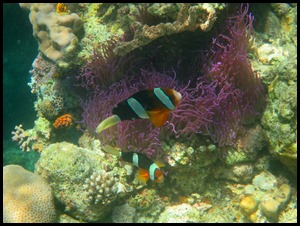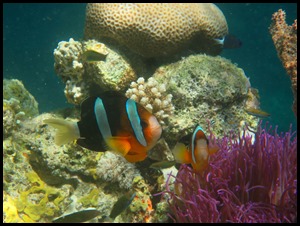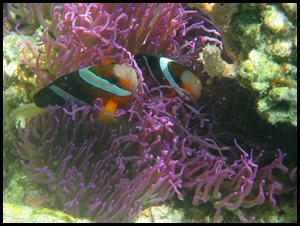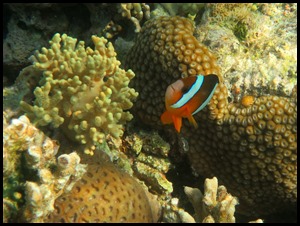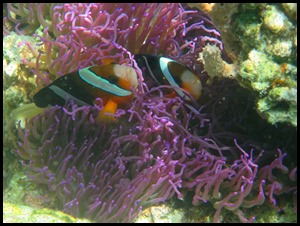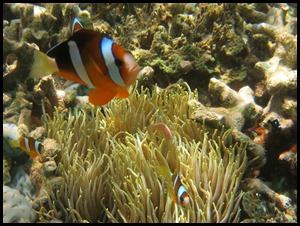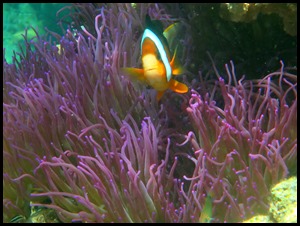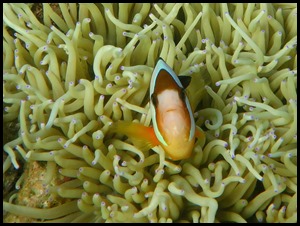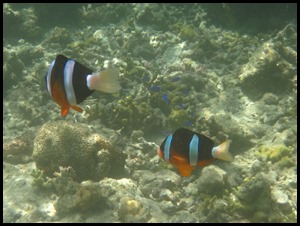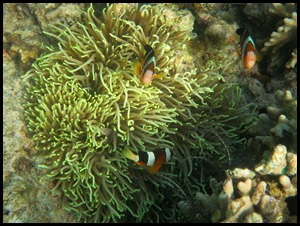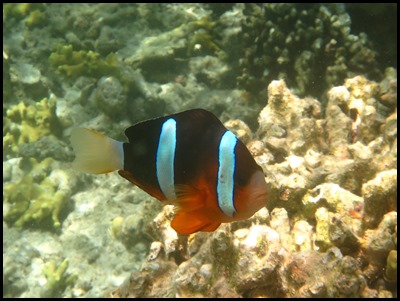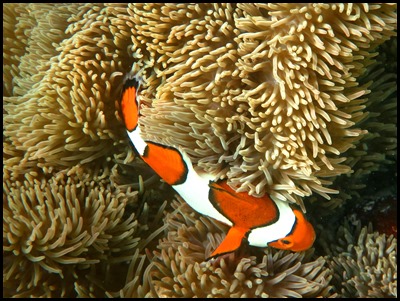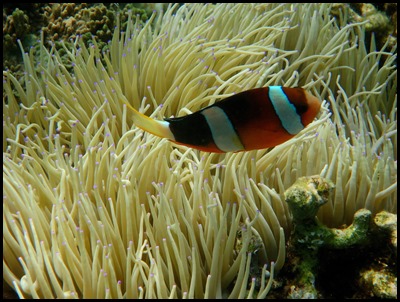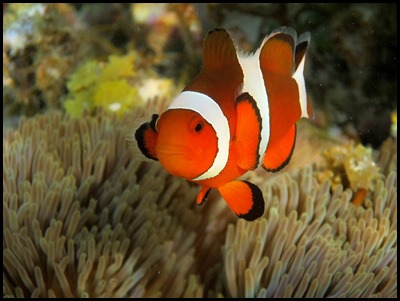Hoga False Clownfish

|
Hoga False
Clownfish
 I found this really good article on
LiveScience by Alina Bradford giving us all we need to know about the happiest,
smile-creating creature – False clownfish, his cousins,
friends and neighbours.
 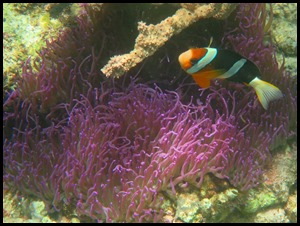 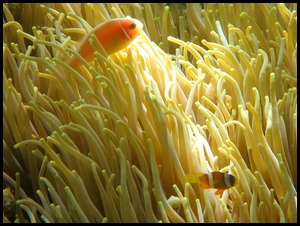 Anemones: White house,
purple house, hairy
house.
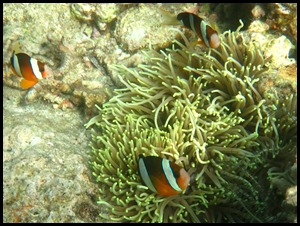 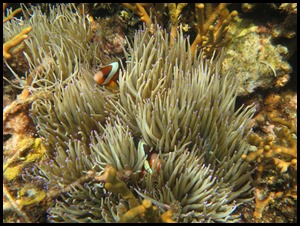 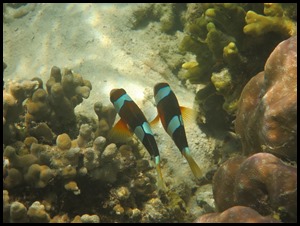 Green
house, grey house and al
fresco.
Facts About Clownfish: Best known for being featured in the movies “Finding Nemo” and “Finding Dory,” the clownfish has become a popular aquarium pet. Nemo and his dad, Marlin, are ocellaris clownfish, also called false clownfish or clown anemonefish. Anemonefish are so-named for the sea anemones in which they make their homes. There are 28 species of anemonefish, and they come in many colours, such as pink, red, yellow, black, brown and multi-coloured stripes.
Size and Description: Most false clownfish are orange with three white bands on the head and body. The white bands are outlined in black. Their bodies are a bit more than 3 inches (88 millimetres) long on average, but they may grow up to 4 inches (110 mm), according to the Animal Diversity Web (ADW). The tail is rounded and the dorsal fin is lined with 11 spines.
Habitat: False clownfish live in the coral reefs off the coasts of Australia and Southeast Asia as far north as southern Japan. They are found mainly around certain kinds of anemones, a creature that anchors itself to the sea floor and uses its tentacles to attract food. The anemone's tentacles have stinging cells called nematocysts that release a toxin when prey or predator touches it. Clownfish, however, develop immunity to the toxin by very carefully touching the tentacles with different parts of their bodies, according to National Geographic. A layer of mucus builds up, protecting the clownfish from the toxin. The pair forms a symbiotic relationship. The anemone provides protection and leftovers for the clownfish, while the clownfish brings food to the anemone and preens its host, removing parasites.
Habits: All anemonefish, including clownfish, are hermaphrodites. They are all born male, according to National Geographic. They have the ability to turn themselves female, but once the change is made, they can’t go back to being male. Sometimes the change is made when mating. Two males will become mates and the larger, dominant fish will become the female. These social fish live in groups that are led by one dominant female, according to the ADW. The second largest fish is the dominant male while all of the other fish in the group are smaller males. If the female dies, the dominant male will become a female to replace her. The largest of the smaller males will then become the dominant male of the group. Clownfish communicate by making popping and clicking noises, according to a study on the journal PLOS One. Researchers say the chatter helps maintain the rank and file among group members. "Sound could be an interesting strategy for preventing conflict between group members," lead study author Orphal Colleye, a postdoctoral fellow at the University of Liège, Belgium, told LiveScience in a 2012 article.
Diet: Clownfish are omnivores, which means they eat meat and plants. They typically eat algae, zooplankton, worms and small crustaceans, according to the National Aquarium. When small, the fish tend to stay within the confines of their anemone host. As they get larger, they will seek out food, though they don't venture much more than a few meters from the anemone, according to the ADW.
Mating and Offspring: Little is known specifically about false clownfish mating behaviours, but the general behaviours of anemonefish are known. All anemonefish are monogamous. Before spawning, the male prepares a nest by clearing a spot on bare rock near the anemone, according to the ADW. He then courts a female with a show of extended fins, biting and chasing, according to the Florida Museum of Natural History. He chases the female to the nest, but after that it is up to her to make the next move. She will make several passes over the nest before depositing her eggs. She will lay from 100 to 1,000 eggs, which are 3 to 4 millimetres long. The male then passes over the nest and releases sperm to fertilize the eggs. Then, the female swims off. The male does most of the "egg sitting." He will fan them and eat any eggs that are infertile or damaged by fungus, according to the ADW. The eggs hatch six to eight days later. The larvae float away and spend about 10 days adrift. They start their lives clear or transparent, but as they begin to mature they start to gain the colour of their species. As juveniles, the young will settle to the bottom of the reef to search for a host anemone.
Taxonomy of false clownfish: according to the Integrated Taxonomic Information System (ITIS): Kingdom: Animalia
Conservation Status: Ocellaris clownfish are not endangered. However, in the last generation, 15 to 30 per cent of the world's reefs have been lost, according to the ADW. Some of the destruction has been caused by fishermen catching clownfish to sell as pets. According to National Geographic, since “Finding Nemo” premiered clownfish sales have tripled. Conservationists are concerned about the "Nemo Effect," as some areas are overfished to meet the demand for these popular aquarium fish. Also, according to the Aquarium Welfare Association (AWA), many people bought the clownfish without knowing how to properly care for them. Inspired by a line in the movie, hundreds of children flushed their clownfish down the toilet in the hope of setting them free.
Other Facts: Clown anemonefish (Amphiprion ocellaris) are called false clownfish because they resemble the orange clownfish (Amphiprion percula). There are some subtle differences between them, according to the Florida Museum of Natural History: · The clown anemonefish has thin black bands, while the orange clownfish has thick black bands separating the orange and white coloration of the body. · The clown anemonefish often has a slightly less brilliant colour than the orange clownfish.
· Viewed head-on, the clown anemonefish's head appears plain while the orange clownfish's head has a pronounced bulging face similar to a frog. · The clown anemonefish's eyes are greyish orange and appear to be larger than they actually are; the orange clownfish has a bright orange iris, which has the effect of making the eyes look smaller.
ALL IN ALL PERFECT
JOY
CHEEKY LITTLE
CHAPS |

